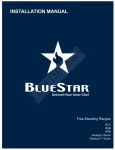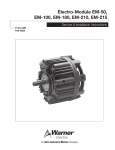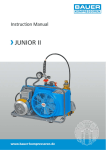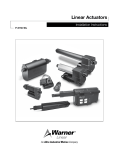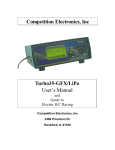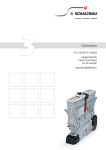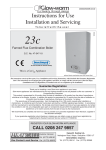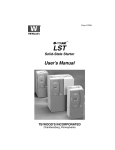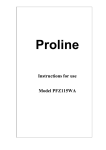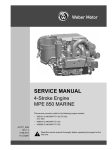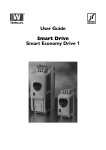Download Torsiflex-I Coupling - Altra Industrial Motion Literature Portal
Transcript
Torsiflex-I Coupling P-5022-TBW Service & Installation Instructions An Altra Industrial Motion Company Contents 1.0 General Notes 1 1.1 Do’s 2 1.2 Don’ts 2 1.3 Description of Coupling 3 1.4 Torsiflex-I Coupling Data 3 2.0 Operating Conditions 4 3.0 Product identification / marking for non-electrical equipment 5 4.0 Limitations of product use 5 5.0 Product servicing 6 6.0 Maintenance Instructions 6 7.0 Alignment Instructions 6 7.1 Alignment Method 6 7.2 Axial Alignment 7 7.3 Parallel / Radial / Angular Alignment 7 7.4 Installation and Operating Misalignment Limits 8 7.5 Limited End Float Coupling 9 8.0 Installation Instructions 9 9.0 Removal Instructions 11 It is essential that a competent person carry out all the instructions contained in the following documents. Should any problems be anticipated or encountered then TB Wood’s personnel are available for site visits or, alternatively, repairs and overhauls can be undertaken in our facility. Prior to performing any maintenance work (including inspections) it is essential that the power supply is isolated and that no accidental movement of rotating machinery is possible. This product is designed for a specific purpose. It is vital that it is not used for any purpose other than that for which it is designed and supplied, and that the limits of it’s capacities, as detailed here or in any other document, are not exceeded. The following instructions should be read and understood prior to starting any assembly or maintenance work on the Torsiflex-I disc coupling. Prior to fitting any component, care should be taken to ensure that it is clean and free from any dirt. When tightening any bolts or screws, this should be done evenly, cylinder head fashion, to 50% torque then to 100% torque in the same sequence. Where specified it is essential that torque-tightening figures are not exceeded nor should it be allowed for them to be below specification. While installing and removing the transmission unit*, the unit should be supported to ensure that the weight is not imposed on one side only. Record the TB Wood’s order number, coupling type and size and any relevant information for future use. Contact TB Wood’s for repair work and spare components. Do not use any components that are not supplied or approved by TB Wood’s in the assembly of this product. Do not attempt, where the weight of the unit is excessive, to lift the coupling without the use of lifting equipment. The inherent balance of these couplings could be disturbed if they are allowed to be knocked either by striking or rolling. Care should be taken when transporting and fitting to avoid such knocks.This is particularly important when a coupling is specifically balanced. * refer to section 8, figure 3 for definition of Transmission Unit No liability will be accepted and any warranty, either expressed or implied, will be null and void should any component of whatever kind, including nuts, bolts and washers, be used in the assembly, or modifications be made to all or part of the product which are not supplied, specified or agreed by TB Wood’s. 2 Ameridrives • Bibby • 512-353-4000 P-5022-TBW • 4/15 1.3 Description of Couplings The Torsiflex-I coupling is of the dry disc type. Flexibility is obtained by the deformation of the disc packs, within defined limits, which are separated by a tubular spacer. Individual discs are of regular polygonal profiles, which are assembled into a stack of previously designated thickness, supported by washers on each side. Flexibility is accomplished by connecting through the holes, on a common bolt circle diameter, by means of bolts, alternately, to driving and driven components. The bolts, washers and associated holes are machined to close limits associated with “fitted bolts”. Due to the need for reasonable ease of assembly, interference fits are undesirable and, consequently, tolerances are such as to allow for a close slide or slight transition fit. To compensate for these clearances and to ensure the best possible concentricity between components, the bolt circle diameter of the bolt holes in the flexible element is made smaller than that of the mating holes in the adjacent components. On assembly, all inherent clearances are, therefore, eliminated. Coupling bolts are sized such that they are capable of inducing a load equivalent to 4 times the tensile load in the flexible element discs, between driving and driven bolt, when transmitting the full rated continuous torque of the coupling. This assumes a coefficient of friction between the various components of 0.25 but experience has shown that, due to the high loads induced, minute compressive deformation is sufficient to raise this to about 0.3. 1.4 Torsiflex-I Coupling Data •Specifically designed for the process pump and general industrial markets. •Plug-in design allows installation and removal without disturbing the hubs •Standard couplings fully compliant with the requirements of API 610. • Incorporates anti-flail feature • Compliance with API 671/ ISO 10441 available • Large hubs available on first two sizes Figure 1 The reason for adopting this principle of using large, highly loaded, bolts is two-fold a) to prevent interface slip, as already mentioned, and b) to eliminate any chance of bolt bending due to the overhung radial loading imposed by the flexible element. Avoiding either slip or bending helps to avoid fretting which occurs when bolts are designed only to drive in shear. Pairs of coupling washers are used to “sandwich the disc packs”, one thin, (the element washer), and one thick, (the overload washer). The overload washers locate in close clearance holes in the coupling adaptor plates. In the unlikely event of a severe overload the overload washers will contact the side of the clearance hole, thus preventing failure of the elements and ensuring drive is maintained. In general, the design is identical to a large number of units supplied and fitted for many years by Turboflex. Ameridrives • Bibby • 512-353-4000 P-5022-TBW • 4/15 3 Table 1 3 Product identification/marking for non-electrical equipment. 2 Operating Conditions In operation the flexible elements are subjected to both tensile and bending stresses, each having an influence on the allowable magnitude of the other. It is important, therefore, that the operating limits of the various deflections for which the coupling is designed to accommodate, are kept, as far as practicable, within those indicated on the “Allowable Misalignment Curve”. In practice, the initial alignment of the coupling should be as close as possible and within the alignment limits given in the section 8.0 “Installation Instructions”. This will allow for changes during operation to remain within allowable limits. As the Ameridrives • Bibby units are designed to transmit the torque in friction between the driving and driven bolts and the flexible elements, it is essential that, should the need arise, these bolts should be correctly tightened to the torque indicated on the assembly drawing or in the “Installation and Maintenance Instructions”. Torque and speed should remain within the originally specified conditions. Scope: Torsiflex-I Disc Coupling Assemblies, excluding component spares. Equipment manufactured or supplied by Ameridrives • Bibby is marked legibly and indelibly, in a variety of ways, with the following (subject to contractual obligations permitting): • Name and telephone number of manufacturer •Designation of the series or type and size (Part Number) •Contract/Order Number and if applicable the unique serial number If applicable, for equipment intended for use in potentially explosive atmospheres, the following will be marked on the equipment in accordance with the ATEX Directive 94/9/EC and EN 13463-1 • Name and address of manufacturer •Designation of the series or type and size (Part Number) •Contract/Order Number and if applicable the unique serial number • CE Mark. • Year of construction •Document of Conformity identification to ATEX Directive 4 Ameridrives • Bibby • 512-353-4000 P-5022-TBW • 4/15 The specific marking of explosion protection followed by the symbol of the equipment group and category •The letter ‘G’ (concerning explosive atmospheres caused by gases, vapors or mists); and/or the letter ‘D’ (concerning explosive atmospheres caused by dust) • The letter ‘c’ for constructional safety •The ambient temperature range when different to -328° F to 725° F (–200° C to 400° C) 4 Limitations of product use Unless otherwise agreed with Ameridrives • Bibby, these products must be selected in accordance with the recommended selection procedure and must only be used within the performance criteria set out below: - The rated torque capacities, which are stated in the product catalogue and/or product arrangement drawing. A continuous temperature range of -4° F (-20° C) to 300° F (149° C) within the permissible operating limits for angular, radial and axial misalignment, section 7.5, Table 4, and standard hardware. High temperature designs available for temperatures up to 536° F (280° C). 5 Product servicing Although with proper selection and careful installation a long working life and very high degree of operational safety can be expected, we would recommend that for ATEX certified couplings the element assembly, coupling bolts and attachment screws are replaced at 50000 operational hour intervals. The operation of a damaged coupling in a hazardous area is contrary to ATEX and in doing so becomes an explosive hazard and is wholly the end users responsibility. 6 Maintenance Instructions General maintenance of the coupling consists of a check of the following during normal machinery maintenance schedules. API617 references this time period as 3 years for compressor applications. this inspection is still possible without disturbing the element bolting. The element packs should be replaced at the earliest opportunity should cracking / damage be detected. Ameridrives • Bibby uses self locking nuts. This gives a high level of performance over many reinstallations. Note: Any requirement for spare parts should be made quoting the original purchasers original purchase order number and the coupling serial number. (This will be etched on the major coupling flanges) and will appear on all documentation. 7 Alignment Instructions Torsiflex-I will accept substantial amounts of misalignment, the configuration of each individual unit defining the actual acceptable level. The allowable misalignment is shown graphically on a curve section 7.4. This curve shows the maximum permitted level of misalignment for operation and is NOT intended to define set up limits. 7.1 Alignment Method: Each company has its own method for aligning machinery all of which are well documented in both internal and freely available documents and books. Hence it is not our intention to describe methods for setting machines. Instead, the following gives guidelines for quick checks for alignment suitable after initial installation and for general maintenance checks. 7.2 Axial Alignment The suggested limits for axial set up distance between the machinery shafts are as shown in Table 2. Table 2 Sizes No. of Bolts TFI0027 to TFI1310 6 Tolerance on DBSE + 0.012 in TFI1900 to TFI2500 8 + 0.010 in Axial, Angular & Parallel misalignment to ensure that these are still within the acceptable limits and that no major movements have occurred. All bolts to ensure that they are correctly tightened. Inspect the flexible elements visually -for signs of fatigue cracking local to the washer anchoring points or general signs of fretting corrosion. Slight bowing or “S” like distortion is not detrimental to the operation of the unit. Note that any cracking will begin at the outermost edge of the outside blade. This means that Ameridrives • Bibby • 512-353-4000 P-5022-TBW • 4/15 5 7.3 Parallel / Radial / Angular Alignment; Having basically aligned the machinery shafts using one of the established techniques, the coupling may be installed as per the instructions. It is then worth performing a check to establish that the overall alignment is correct for the particular coupling. This may be simply performed by one of the following two methods: 7.4 Installation and Operating Misalignment Limits The following curve shows the general allowable running misalignment limits Attach a dial indicator securely to the back of one of the coupling flanges, with the needle in contact with the flange face the other side of the flexible element as near the outside periphery as possible. Rotate the machinery & coupling and locate the minimum reading position. At this position, set the dial reading to zero. Rotate the machinery again and record the maximum reading over 360 degrees. Divide this maximum value by the coupling flange diameter to gain a value in in/in, which should be no greater than that shown in Table 3. (This should be repeated at both flexible elements in a spacer coupling). An alternative method is, where possible, to accurately measure the distance across the flanges that sandwich the flexible element (element gap) to obtain a maximum and minimum value. The difference between these two values should be divided by the flange outside diameter to obtain a value in in/in, which should be no greater than that shown in Table 3. (This should be repeated at both flexible elements in a spacer coupling). Table 3 Sizes No. of Bolts TFI0027 to TFI1310 6 Tolerance Element Gap + 0.003 in/in TFI1900 to TFI2500 8 + 0.002 in/in Figure 2 See next page to identify reference points 1. Combined angular/radial misalignment 2. 1 degree angle is equivalent to 0.17 in/in 3. At zero speed (Static) 4. At maximum speed and continuous rated torque The coupling shall operate within this envelope (below the allowable misalignment curve) and providing these limits are not exceeded at any time, the coupling should enjoy a trouble free life. NOTE: These values are intended as guides only and, in certain cases, may be exceeded. IF IN DOUBT, CONTACT Ameridrives • Bibby. 6 Ameridrives • Bibby • 512-353-4000 P-5022-TBW • 4/15 Table 4 - TFI Misalignment Data Coupling Size TFI Max. Angular Misalignment (Deg.) Bending Moment (ft.lb./deg.) Point A (1) (2) (4) Max. Axial Deflection (Zero Angular Misalignment) (in.) Max. Axial Thrust (lbf.) Max. Axial Deflection at full Angular Misalignment (in.) Point C (3) Per Element Axial Thrust (lbf.) Point B (4) Per Assembly 27 0.5 23 .067 126 .019 15 38 0.5 20 .087 112 .019 9 140 0.5 20 .106 287 .019 20 260 0.5 30 .130 542 .024 28 400 0.5 66 .169 917 .055 112 750 0.5 108 .197 1380 .071 202 1310 0.5 164 .236 1971 .087 292 1900 0.33 277 .197 2473 .059 337 2500 0.33 369 .212 2900 .067 337 3300 0.33 435 .236 3518 .071 405 6000 0.33 704 .295 5170 .094 607 8500 0.33 1025 .319 7531 .110 1124 12000 0.33 1261 .354 8587 .118 1124 7.5 Limited End Float Couplings N.B. In the case of special limited end float (LEF) versions the amount of axial movement is physically restricted and therefore the values shown in the above table do not apply. In these cases please refer to the coupling drawing for reference to the amount of axial movement the coupling is capable of. For general Safety, Alignment and Maintenance Instructions see other sections of this manual. IMPORTANT: The main Coupling Bolts/Nuts at both ends are tightened by Ameridrives • Bibby, and should, under normal circumstances, NOT BE TOUCHED unless specified in the installation instructions. 8.0 Installation Instructions No liability will be accepted, and any warranty, either expressed or implied, will be null and void should any components of whatsoever kind, including nuts, bolts and washers, be used in the assembly or any modifications be made to all or part of the unit which are not supplied, specified or agreed by Ameridrives • Bibby. When tightening any other bolt or screw, this should be done evenly, i.e. cylinder head fashion, to 50% torque then to 100% torque in the same sequence. Threads should be lubricated with Molybdenum Disulphide grease or equivalent. Reference table 6 for tightening torques. Ameridrives • Bibby • 512-353-4000 P-5022-TBW • 4/15 7 Check that the parallel & and axial misalignments of the shafts are within the limits defined in the alignment curves, section 7.4, Figure 2. Ameridrives • Bibby do not recommend any specific alignment method as this varies due to personnel preference; however the alignment should be within the operational envelope shown on the misalignment curve. 8.1 Reference any applicable drawings for sizes and dimensions. Ensure that all required tools and equipment are available. 8.2 The coupling is supplied in an assembled state with its misalignment capabilities locked by installation screws near the element packs. The coupling is packed appropriately for transportation and storage. Inspect the coupling for: •Indication of deviation from specification to ensure that it conforms to requirements. • Potential damage due to transportation. 8.3 For balanced couplings, note any match markings, which must be aligned when the coupling is installed. 8.4 The Torsiflex-I coupling hubs must be removed from the transmissions unit – see figure 3. to allow installation. Remove the connecting nuts and bolts from the hub/adaptor flanges and using jacking screws force the flanges apart. Store the nuts and bolts along with the packing ring and shims (if supplied) for future stages of installation. 8.5 The hubs may now be fitted to the driver and driven shafts. The method of fitting will be dependant on the type of fit specified for the particular installation. In all cases the hub face should be in line with the shaft end. Where hub/shaft connections require a standard interference fit the hubs may be heated in an oil bath or oven at 392-482° F (200-250° C) and rapidly positioned on the shaft. It is essential that this heat is evenly applied over the whole hub and that spot heating is avoided. Ensure that one shaft rotates so that the coupling match marks can be aligned. 8.6 Check the shafts misalignments and DBSE (distance between shaft ends) are within allowable limits. (Reference Section 7.4). 8.7 The main bolts in the transmission unit are factory assembled and must not be disturbed. Undo the installation screws; the coupling should now be in a relaxed state. If no packing ring or shims are supplied, go to step 8.12. 8.8 Measure the free length of the transmission unit. Add to this the thickness of the packing plate. Record this value as X. Figure 3: Coupling Construction Component Parts 1.Hubs 2.Spacer 3.Adaptor 4. Element Washer 5. Element Washers 6. Element Blades 7. Coupling Bolt 8. Coupling Nuts 9. Attachment Screws 10. Installation Screws 11.Shims 12. Packing Plate 8 Ameridrives • Bibby • 512-353-4000 8.9 Now measure the distance between the shaft ends (DBSE) of the machinery. Adjust this length by either subtracting pre-stretch or adding pre-compression. Record this value as Y 8.10 Calculate the required number of shims from the following equation Number of shims = (Y-X) ÷ shim thickness Round this value to a whole number of shims. Shim thickness is 0.015 inches. P-5022-TBW • 4/15 8.11 Fit shims between packing ring and the transmission unit. Ensure match marks are aligned. 8.17 Ensure all match marks are aligned, all tooling is removed and inspect the coupling before operation. 8.12 Install the installation screws Ref 10, and tighten in cylinder head fashion, maintaining parallelism between the flange faces of the adaptor and spacer, until both elements packs are compressed by a minimum required amount to allow the transmission unit to be put into position. Do not compress the elements beyond the value stated in “Maximum Element Compression” Values. These values express the maximum amount of compression allowed per element pack. However, it is recommended to use the minimum amount of compression required when installing couplings. 9.0 Removal Instructions. Coupling removal is a reverse of the above installation process ensuring that, upon reinstallation, the above process is again followed in careful sequence. Table 5 Coupling Size TFI Maximum Compressions (in) per element pack 27 0.059 38 0.069 140 0.079 260 0.090 400 0.090 750 Table 6 : When tightening any other bolt or screw, this should be done evenly, i.e. cylinder head fashion, to 50% torque then to 100% torque in the same sequence. Threads should be lubricated with Molybdenum Disulphide grease or equivalent IMPORTANT: The main Coupling Bolts/Nuts at both ends are tightened by Ameridrives • Bibby, and should, under normal circumstances, NOT BE TOUCHED unless specified in the installation instructions Table 6 Disc Pack Bolting Bolt Stretch Alternate Bolt Torque Hub Attachment Screw (in) (ft* lb) (ft* lb) 0.0014 7 7 0.0014 7 17 140 0.0028 33 7 260 0.0031 55 17 0.118 400 0.0031 83 17 0.138 750 0.0041 166 32 8500 0.138 1310 0.0044 273 53 12000 0.157 1900 0.0038 273 53 2500 0.0044 354 133 3300 0.0057 553 133 6000 0.0068 811 258 8500 0.0077 1401 350 12000 0.0091 1844 467 Coupling Size 0.098 27 1310 0.118 38 1900 0.118 2500 0.118 3300 6000 8.13 Position the transmission unit between the shaft ends (hub faces), ensuring match marks are aligned. 8.14 Fit and tighten in cylinder head fashion the connecting bolts that pass through the packing ring and shims. Reference table 6 for tightening torques. 8.15 Release and remove the installation screws. 8.16 Fit and tighten in cylinder head fashion the attachment screws that pass through the remaining flange. If a pre-stretch is present, it may be necessary to pull the flanges together using the attachment screws. Reference table 6 for tightening torques. Ameridrives • Bibby • 512-353-4000 P-5022-TBW • 4/15 9 TORSI-LOCK Shrink Disc Mounting Instructions Notes: The shrink rings are supplied assembled and ready to mount. Only the larger units, where the weights involved make handling difficult, should be disassembled to facilitate mounting. Mounting Instructions Screws (Grade 10.9) Wrench SIZE (mm) Tightening Torque Nm ft.lb M5 8 5 3.6 M6 10 12 8.7 M8 13 30 22 M10 17 59 44 M12 19 100 74 M16 24 250 185 M20 30 490 362 M24 36 840 620 1. Remove any spacers which may have been ar ranged between the pressure rings as protection during transport. 2. The screws should only be tightened to such a degree that the inner ring can still be turned freely. 3. Apply grease to the surface of the hub on which the shrink ring seats. 4. Push the shrink ring onto the hub. Attention: Do not begin tightening the screws before the shaft is in place in the hub bore, otherwise permanent deformation will result. 5. Push the hub onto the shaft, both contact surfaces beeing ungreased. Disassembly 1.Loosen the screws evenly one after the other, again going round several times to avoid canting 6. Make sure the shrink ring is aligned, i.e. the pressure rings are in parallel planes, by tightening of the plates on the inner ring. the screws with a short wrench. 7. Tighten the ring by tensioning the screws evenly one after the other in a clockwise direction (not in a “crosswise” fashion). It will be necessary to go round several times before all the screws are torqued down to the recommended value. (For torque val ues and required wrench lenghts see table). Check with a torque wrench. The tightening torque is either punched into the material with smaller units, or is indicated on a plate. 10 Ameridrives • Bibby • 512-353-4000 Under no cicumstances whatsoever should the screws be totally disengaged, since this could lead to a ring jumping off. (think safety) 2. Before the shaft is dismantled or the hub pulled off, any rust on the hub or shaft should be removed. 3. Remove the shrink ring from the hub. P-5022-TBW • 4/15 Cleaning and Regreasing Shrink rings which have been in service should be totally dismantled and cleaned. The bevel surfaces are factory lubricated with a solid lubricant (e.g. Weicon, “Anti-Seize”). Undamaged bevel surfaces should be regreased only with “Anti-Seize”, which should likewise be applied to threads and screw-head bearing surface. Ameridrives • Bibby • 512-353-4000 P-5022-TBW • 4/15 11 An Altra Industrial Motion Company www.tbwoods.com 2000 Clovis Barker Road San Marcos, TX 78666 512-353-4000 Fax: 512-353-4017 P-5022-TBW 4/15 www.altramotion.com Printed in USA












